
Ringing on GDT. Can it be stopped with RC snubber? (no choice but to dupilcate)
Gregary Boyles, Tue Apr 18 2017, 05:53PMIf so how do you apply RC snubbers to this schematic:
I tried puting one in parallel with the GDT primary (1k + various caps) but it seemed to have littee effect on the ringing.
220R for R4 & R3 seemed the flatten out the ringing but then I am significantly reducing current to the FET gates.
GDT:
4 strands of AWG 30 twisted together to form 3 'wires'.
3 of these are then twisted together to form a trifilar 'wire' which was then wrapped around the torroid.
Torroid material: N30
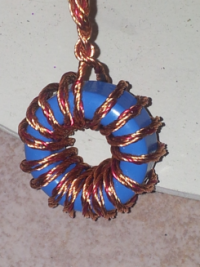
Ringing on GDT primary
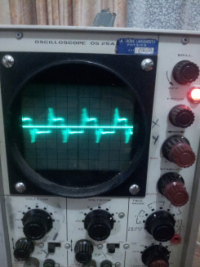
Ringing on both GDT secondaries with peak voltage one lower than the other. Why?

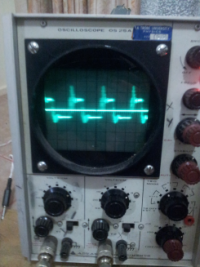
Re: Ringing on GDT. Can it be stopped with RC snubber? (no choice but to dupilcate)
johnf, Tue Apr 18 2017, 08:03PM
first put a 10K resistor across each gate to source
second put RC snubbers across D1 and D2 as you have not given details of your oscilloscope settings I cannot help further
johnf, Tue Apr 18 2017, 08:03PM
first put a 10K resistor across each gate to source
second put RC snubbers across D1 and D2 as you have not given details of your oscilloscope settings I cannot help further
Re: Ringing on GDT. Can it be stopped with RC snubber? (no choice but to dupilcate)
Gregary Boyles, Wed Apr 19 2017, 06:56AM
The oscilloscope is on the 1us scale, although there doesn't seem to be any way of telling how much the fine scale adjustment alters the time scale.
Resistor from gate to source? Oh I see what you mean - a discharge path that does not have to go through the GDT secondaries (inductors)
I was assuming the ringing was coming from the GDT but you have made me realize that it could be coming from the Tesla primary.......which would explain why trying various combinations of resistor + cap across the GDT secondaries was having little effect.
Gregary Boyles, Wed Apr 19 2017, 06:56AM
johnf wrote ...
first put a 10K resistor across each gate to source
second put RC snubbers across D1 and D2 as you have not given details of your oscilloscope settings I cannot help further
first put a 10K resistor across each gate to source
second put RC snubbers across D1 and D2 as you have not given details of your oscilloscope settings I cannot help further
The oscilloscope is on the 1us scale, although there doesn't seem to be any way of telling how much the fine scale adjustment alters the time scale.
Resistor from gate to source? Oh I see what you mean - a discharge path that does not have to go through the GDT secondaries (inductors)
I was assuming the ringing was coming from the GDT but you have made me realize that it could be coming from the Tesla primary.......which would explain why trying various combinations of resistor + cap across the GDT secondaries was having little effect.
Re: Ringing on GDT. Can it be stopped with RC snubber? (no choice but to dupilcate)
hen918, Wed Apr 19 2017, 10:37AM
Increasing the value of R3 and R4 can be used to reduce ringing, but it increases the switching times of the IGBTs, so it's a balancing act.
hen918, Wed Apr 19 2017, 10:37AM
Increasing the value of R3 and R4 can be used to reduce ringing, but it increases the switching times of the IGBTs, so it's a balancing act.
Re: Ringing on GDT. Can it be stopped with RC snubber? (no choice but to dupilcate)
Gregary Boyles, Wed Apr 19 2017, 11:34AM
What is your view with this non-dissipative snubber circuit?
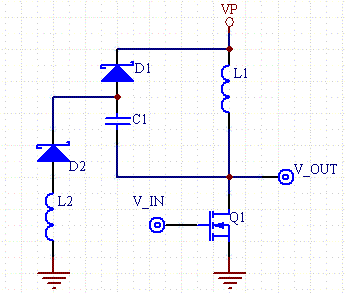
https://www.daycounter.com/Calculators/Snubbers/Snubber-Design-Calculator.phtml
Is there any reason why it would interfere with the correct operation of this particular circuit?
And I assume I could get away with 1N1819 as D2 since the current involved with the voltage spikes would be under 1A.
Gregary Boyles, Wed Apr 19 2017, 11:34AM
hen918 wrote ...
Increasing the value of R3 and R4 can be used to reduce ringing, but it increases the switching times of the IGBTs, so it's a balancing act.
Increasing the value of R3 and R4 can be used to reduce ringing, but it increases the switching times of the IGBTs, so it's a balancing act.
What is your view with this non-dissipative snubber circuit?

https://www.daycounter.com/Calculators/Snubbers/Snubber-Design-Calculator.phtml
Is there any reason why it would interfere with the correct operation of this particular circuit?
And I assume I could get away with 1N1819 as D2 since the current involved with the voltage spikes would be under 1A.
Re: Ringing on GDT. Can it be stopped with RC snubber? (no choice but to dupilcate)
hen918, Wed Apr 19 2017, 02:25PM
The snubbers on the daycounter website are design to prevent flyback on the output of the 'FETs. You seem to have a problem with ringing on the gates. This is due to nasty parasitic capacitiances and inductances between the output of the gate drivers and the inputs of the MOSFETs.
One thing you can try is placing a small value resistor in series with the primary of the GDT. I would suggest trying 2 to 5 ohms.
On another note, your duty cycle seems to be more like 60/40 than 50/50. This is causing the capacitor to shift voltages to maintain GDT flux balance. To provide an even voltage, provide an even duty cycle.
hen918, Wed Apr 19 2017, 02:25PM
The snubbers on the daycounter website are design to prevent flyback on the output of the 'FETs. You seem to have a problem with ringing on the gates. This is due to nasty parasitic capacitiances and inductances between the output of the gate drivers and the inputs of the MOSFETs.
One thing you can try is placing a small value resistor in series with the primary of the GDT. I would suggest trying 2 to 5 ohms.
On another note, your duty cycle seems to be more like 60/40 than 50/50. This is causing the capacitor to shift voltages to maintain GDT flux balance. To provide an even voltage, provide an even duty cycle.
Re: Ringing on GDT. Can it be stopped with RC snubber? (no choice but to dupilcate)
Sulaiman, Wed Apr 19 2017, 02:29PM
with no ac power to the output bridge,
connect C12 in parallel with C9 to see more like operational gate waveforms.
use a 10R 10W resistor in place of L1 if L1/L2 not ready.
Sulaiman, Wed Apr 19 2017, 02:29PM
with no ac power to the output bridge,
connect C12 in parallel with C9 to see more like operational gate waveforms.
use a 10R 10W resistor in place of L1 if L1/L2 not ready.
Re: Ringing on GDT. Can it be stopped with RC snubber? (no choice but to dupilcate)
Gregary Boyles, Wed Apr 19 2017, 05:01PM

So I could experiment with the effect of duty cycle.
I also have a 300pF tuning cap in parallel with the timing cap for fine adjustments to the frequency.
I have marked the position on my enclosure of 50% duty cycle.
But I have noticed that it really messes up the wave form if I go below 50% duty cycle.
I have my control box connected to the coil and driver circuit via a 3m long lead so that is probably a source of some of the parasitic capacitance and inductances.
But I didn't really want to be standing right next the the discharge while playing with the controls.
I will try your small value resistor trick and see if that improves the waveform.
Can you also suggest a website that fully explains and details strategies for dealing with ringing in this type of circuit?
Gregary Boyles, Wed Apr 19 2017, 05:01PM
hen918 wrote ...
The snubbers on the daycounter website are design to prevent flyback on the output of the 'FETs. You seem to have a problem with ringing on the gates. This is due to nasty parasitic capacitiances and inductances between the output of the gate drivers and the inputs of the MOSFETs.
One thing you can try is placing a small value resistor in series with the primary of the GDT. I would suggest trying 2 to 5 ohms.
On another note, your duty cycle seems to be more like 60/40 than 50/50. This is causing the capacitor to shift voltages to maintain GDT flux balance. To provide an even voltage, provide an even duty cycle.
I used this 555 astable circuit so that I could experiment with the duty cycle with a double gang pot for R1 and R2 plus 2 x 1.2k in series with both sides of the pot to fix the minimum and maximum duty cycles at about 10% and 90%.The snubbers on the daycounter website are design to prevent flyback on the output of the 'FETs. You seem to have a problem with ringing on the gates. This is due to nasty parasitic capacitiances and inductances between the output of the gate drivers and the inputs of the MOSFETs.
One thing you can try is placing a small value resistor in series with the primary of the GDT. I would suggest trying 2 to 5 ohms.
On another note, your duty cycle seems to be more like 60/40 than 50/50. This is causing the capacitor to shift voltages to maintain GDT flux balance. To provide an even voltage, provide an even duty cycle.

So I could experiment with the effect of duty cycle.
I also have a 300pF tuning cap in parallel with the timing cap for fine adjustments to the frequency.
I have marked the position on my enclosure of 50% duty cycle.
But I have noticed that it really messes up the wave form if I go below 50% duty cycle.
I have my control box connected to the coil and driver circuit via a 3m long lead so that is probably a source of some of the parasitic capacitance and inductances.
But I didn't really want to be standing right next the the discharge while playing with the controls.
I will try your small value resistor trick and see if that improves the waveform.
Can you also suggest a website that fully explains and details strategies for dealing with ringing in this type of circuit?
Re: Ringing on GDT. Can it be stopped with RC snubber? (no choice but to dupilcate)
Gregary Boyles, Wed Apr 19 2017, 05:03PM
By the way the oscilloscope traces tend to drift a bit vertically and that probably accounts for some of the asymmetry of my waveform.
Gregary Boyles, Wed Apr 19 2017, 05:03PM
By the way the oscilloscope traces tend to drift a bit vertically and that probably accounts for some of the asymmetry of my waveform.
Re: Ringing on GDT. Can it be stopped with RC snubber? (no choice but to dupilcate)
loneoceans, Wed Apr 19 2017, 11:45PM
Side note - if done correctly, using magnet wire can yield a good GDT with sufficient isolation between primary and secondary windings. However it's very easy to nick or stress the insulation, which can lead to a short especially with high bus voltages. As a result, I typically prefer using good (but as thin insulation as possible) insulated wire.
loneoceans, Wed Apr 19 2017, 11:45PM
Side note - if done correctly, using magnet wire can yield a good GDT with sufficient isolation between primary and secondary windings. However it's very easy to nick or stress the insulation, which can lead to a short especially with high bus voltages. As a result, I typically prefer using good (but as thin insulation as possible) insulated wire.
Re: Ringing on GDT. Can it be stopped with RC snubber? (no choice but to dupilcate)
Hazmatt_(The Underdog), Thu Apr 20 2017, 03:11AM
I have had bad luck with the solderable "solder ease" type magnet wire. It tends to break down easily and short.
Any magnet wire that's polyimide, polyester resin, formvar, or enamel coated should work. I think the polyimide (kapton) has an insulation dielectric breakdown voltage of about 2000V, but that would have to be verified by the data sheet for the wire.
Hazmatt_(The Underdog), Thu Apr 20 2017, 03:11AM
I have had bad luck with the solderable "solder ease" type magnet wire. It tends to break down easily and short.
Any magnet wire that's polyimide, polyester resin, formvar, or enamel coated should work. I think the polyimide (kapton) has an insulation dielectric breakdown voltage of about 2000V, but that would have to be verified by the data sheet for the wire.
Re: Ringing on GDT. Can it be stopped with RC snubber? (no choice but to dupilcate)
Gregary Boyles, Thu Apr 20 2017, 04:48AM
Gregary Boyles, Thu Apr 20 2017, 04:48AM
loneoceans wrote ...
Side note - if done correctly, using magnet wire can yield a good GDT with sufficient isolation between primary and secondary windings. However it's very easy to nick or stress the insulation, which can lead to a short especially with high bus voltages. As a result, I typically prefer using good (but as thin insulation as possible) insulated wire.
I tried ethernet cable wires (with solid cores) but they were too stiff and the resulting windings to loose. Any other suggestions as an alternative to magnet wire?Side note - if done correctly, using magnet wire can yield a good GDT with sufficient isolation between primary and secondary windings. However it's very easy to nick or stress the insulation, which can lead to a short especially with high bus voltages. As a result, I typically prefer using good (but as thin insulation as possible) insulated wire.
Re: Ringing on GDT. Can it be stopped with RC snubber? (no choice but to dupilcate)
Gregary Boyles, Thu Apr 20 2017, 04:49AM
That magnet wire was from an old cathode ray tv -the coils at the neck of the tube. I can't seem to solder those without stripping the insulation with sand paper. So I have to assume it is not solderease.
Gregary Boyles, Thu Apr 20 2017, 04:49AM
Hazmatt_(The Underdog) wrote ...
I have had bad luck with the solderable "solder ease" type magnet wire. It tends to break down easily and short.
Any magnet wire that's polyimide, polyester resin, formvar, or enamel coated should work. I think the polyimide (kapton) has an insulation dielectric breakdown voltage of about 2000V, but that would have to be verified by the data sheet for the wire.
How do you tell the difference between them?I have had bad luck with the solderable "solder ease" type magnet wire. It tends to break down easily and short.
Any magnet wire that's polyimide, polyester resin, formvar, or enamel coated should work. I think the polyimide (kapton) has an insulation dielectric breakdown voltage of about 2000V, but that would have to be verified by the data sheet for the wire.
That magnet wire was from an old cathode ray tv -the coils at the neck of the tube. I can't seem to solder those without stripping the insulation with sand paper. So I have to assume it is not solderease.
Re: Ringing on GDT. Can it be stopped with RC snubber? (no choice but to dupilcate)
teravolt, Thu Apr 20 2017, 07:17PM
do you have a picture if you project on your bench? the measurement that you are making is pausibly induced from your set up or a ground loop. if it were real a 470-50 ohm resistor across your transformer should have a dampening affect at your gate. try moving your test leads away from your project and see what happens. if you plan to do this work you would be happy with a better scope
teravolt, Thu Apr 20 2017, 07:17PM
do you have a picture if you project on your bench? the measurement that you are making is pausibly induced from your set up or a ground loop. if it were real a 470-50 ohm resistor across your transformer should have a dampening affect at your gate. try moving your test leads away from your project and see what happens. if you plan to do this work you would be happy with a better scope
Re: Ringing on GDT. Can it be stopped with RC snubber? (no choice but to dupilcate)
Gregary Boyles, Thu Apr 20 2017, 11:55PM
I got better flat tops to my square wave when I powered my circuit from a plug pack AND after I upped the loops on my GDT from 16 to 25. Apparently there is not enough juice in my ATX power supply (at 12V) to power 3 x 12V fans (one in the ATX itself), and my GDT and all the rest of the electronics.
I have also added an option to power the TC4422's I am using (made my own UCC37422/UCC37421 from 2 x TC4422 and a quad AND gate) from 20V with a 3 pole switch to switch the power between 12V, 20V and 'off'.
Will post some more photos when I am done soldering.
Gregary Boyles, Thu Apr 20 2017, 11:55PM
teravolt wrote ...
do you have a picture if you project on your bench? the measurement that you are making is pausibly induced from your set up or a ground loop. if it were real a 470-50 ohm resistor across your transformer should have a dampening affect at your gate. try moving your test leads away from your project and see what happens. if you plan to do this work you would be happy with a better scope
Would love to have a good digital scope but sadly I can't afford several hundred $$$$s at present. So I will have to make do with what I have for the forseeable future. do you have a picture if you project on your bench? the measurement that you are making is pausibly induced from your set up or a ground loop. if it were real a 470-50 ohm resistor across your transformer should have a dampening affect at your gate. try moving your test leads away from your project and see what happens. if you plan to do this work you would be happy with a better scope
I got better flat tops to my square wave when I powered my circuit from a plug pack AND after I upped the loops on my GDT from 16 to 25. Apparently there is not enough juice in my ATX power supply (at 12V) to power 3 x 12V fans (one in the ATX itself), and my GDT and all the rest of the electronics.
I have also added an option to power the TC4422's I am using (made my own UCC37422/UCC37421 from 2 x TC4422 and a quad AND gate) from 20V with a 3 pole switch to switch the power between 12V, 20V and 'off'.
Will post some more photos when I am done soldering.
Re: Ringing on GDT. Can it be stopped with RC snubber? (no choice but to dupilcate)
teravolt, Sat Apr 22 2017, 06:34AM
if you have only one type of driver you can try this. the schematic that you picked is old and does not have current monitoring and some other things and this is the more up to date one
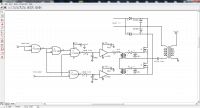


teravolt, Sat Apr 22 2017, 06:34AM
if you have only one type of driver you can try this. the schematic that you picked is old and does not have current monitoring and some other things and this is the more up to date one



Re: Ringing on GDT. Can it be stopped with RC snubber? (no choice but to dupilcate)
Gregary Boyles, Sat Apr 22 2017, 02:14PM
I fried the TC4422s I had. The datasheet says they will run from 20V max so I tried it, but it must have pushed their limits to far and they no longer work.
So I am having a go at creating a darlington H bridge instead, as that will easily take 20V (laptop power supply) and I should get around 16V amplitude on my square wave going through the GDT primary. I am using TIP122/127 and they can take 100V and give me up to 5A. I have a 4.7R resistor in series with the 100nF cap to make sure they don't get over stressed.
I used a half bridge successfully with a plasma globe driver that was some what similar to that schematic just above and with the flyback transformer primary connected between my half bridge and GND.
This H bridge design seem to work in simulation at least:

Gregary Boyles, Sat Apr 22 2017, 02:14PM
teravolt wrote ...
if you have only one type of driver you can try this. the schematic that you picked is old and does not have current monitoring and some other things and this is the more up to date one



if you have only one type of driver you can try this. the schematic that you picked is old and does not have current monitoring and some other things and this is the more up to date one



I fried the TC4422s I had. The datasheet says they will run from 20V max so I tried it, but it must have pushed their limits to far and they no longer work.
So I am having a go at creating a darlington H bridge instead, as that will easily take 20V (laptop power supply) and I should get around 16V amplitude on my square wave going through the GDT primary. I am using TIP122/127 and they can take 100V and give me up to 5A. I have a 4.7R resistor in series with the 100nF cap to make sure they don't get over stressed.
I used a half bridge successfully with a plasma globe driver that was some what similar to that schematic just above and with the flyback transformer primary connected between my half bridge and GND.
This H bridge design seem to work in simulation at least:

Re: Ringing on GDT. Can it be stopped with RC snubber? (no choice but to dupilcate)
Hazmatt_(The Underdog), Sun Apr 23 2017, 04:13PM
How on earth does that circuit work with no pull-up resistors on the transistor bases?!
There is no way that would work, even if you fixed the open node on L1.
Hazmatt_(The Underdog), Sun Apr 23 2017, 04:13PM
How on earth does that circuit work with no pull-up resistors on the transistor bases?!
There is no way that would work, even if you fixed the open node on L1.
Re: Ringing on GDT. Can it be stopped with RC snubber? (no choice but to dupilcate)
hen918, Sun Apr 23 2017, 04:33PM
They are BJTs, not MOSFETs. If there is no current flowing through the base they will not be "on". It's quite a clever design, shorting the two bases together through another transistor pulls the lower one up and the top one down, turn them both on. It might not be very efficient though, but that's only due to the use of transistors.
hen918, Sun Apr 23 2017, 04:33PM
Hazmatt_(The Underdog) wrote ...
How on earth does that circuit work with no pull-up resistors on the transistor bases?!
There is no way that would work, even if you fixed the open node on L1.
How on earth does that circuit work with no pull-up resistors on the transistor bases?!
There is no way that would work, even if you fixed the open node on L1.
They are BJTs, not MOSFETs. If there is no current flowing through the base they will not be "on". It's quite a clever design, shorting the two bases together through another transistor pulls the lower one up and the top one down, turn them both on. It might not be very efficient though, but that's only due to the use of transistors.
Re: Ringing on GDT. Can it be stopped with RC snubber? (no choice but to dupilcate)
Gregary Boyles, Sun Apr 23 2017, 05:25PM
OK thanks folks - I will ditch the idea and go back to the TC4422s. Just thought I would try.
Gregary Boyles, Sun Apr 23 2017, 05:25PM
OK thanks folks - I will ditch the idea and go back to the TC4422s. Just thought I would try.
Re: Ringing on GDT. Can it be stopped with RC snubber? (no choice but to dupilcate)
teravolt, Mon Apr 24 2017, 02:22PM
one problem that I have had with dip drivers is that they can over heat driving transformers at that frequency so I converted to using TO 220-5 packages. a mosfet totem pole "half bridge" could be added to to the mosfet drivers
teravolt, Mon Apr 24 2017, 02:22PM
one problem that I have had with dip drivers is that they can over heat driving transformers at that frequency so I converted to using TO 220-5 packages. a mosfet totem pole "half bridge" could be added to to the mosfet drivers
Re: Ringing on GDT. Can it be stopped with RC snubber? (no choice but to dupilcate)
Gregary Boyles, Wed May 10 2017, 02:14PM
My GDT waveform looks more or less like this:

39 ohms is about the largest damping resistance before is start degrading the output from my top load.....according to a fluorescent light bulb test.
And increasing the resistance further does not seem to make any further difference to the ringing any way.
Are there any more tricks I can try to reduce the rining a bit more apart from increasing damping resistance?
Gregary Boyles, Wed May 10 2017, 02:14PM
My GDT waveform looks more or less like this:

39 ohms is about the largest damping resistance before is start degrading the output from my top load.....according to a fluorescent light bulb test.
And increasing the resistance further does not seem to make any further difference to the ringing any way.
Are there any more tricks I can try to reduce the rining a bit more apart from increasing damping resistance?
Re: Ringing on GDT. Can it be stopped with RC snubber? (no choice but to dupilcate)
teravolt, Wed May 10 2017, 09:44PM
have you tried another core and try using cat-5 wires
teravolt, Wed May 10 2017, 09:44PM
have you tried another core and try using cat-5 wires
Re: Ringing on GDT. Can it be stopped with RC snubber? (no choice but to dupilcate)
teravolt, Thu May 11 2017, 03:46AM
you could try this and hear are the mosfet for Q1,Q2 mosfet driver fets

and use cat-5 for T1 around a toroid. your toroid should have a frequency response 50k to 500kHz. I chose low ohm mosfet and a 1000uf cap to drive the transformer.
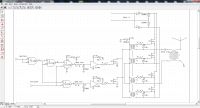
teravolt, Thu May 11 2017, 03:46AM
you could try this and hear are the mosfet for Q1,Q2 mosfet driver fets

and use cat-5 for T1 around a toroid. your toroid should have a frequency response 50k to 500kHz. I chose low ohm mosfet and a 1000uf cap to drive the transformer.

Re: Ringing on GDT. Can it be stopped with RC snubber? (no choice but to dupilcate)
Gregary Boyles, Thu May 11 2017, 04:20PM
Referring to this page: Typical gate drive waveforms
Sorry I didn't specifically state it but the ringing problem is on my GDT primary - is there any benefit to puting a low value resistor in series with the GDT primary cap?
I believe I have this problem with the GDT secondary:

But I am not sure because the droop looks worst on shorter oscilloscope time scales with wider square waves than longer time scales with narrower square wave.
It would be nice to have some idea of what sort of primary inductance you need - at least ball park.
300uH?
800 uH?
3000 uH?
30,000uH?
I have used an N30 toroid which is one of the recommended ferrite materials.
I have used about ASA 22 magnet wire to create a trifiller winding and I have put enough turns on the torroid with this to get an inductance of about 32mH......to see how much improvement I get with the droop in the square wave.
Gregary Boyles, Thu May 11 2017, 04:20PM
Referring to this page: Typical gate drive waveforms
Sorry I didn't specifically state it but the ringing problem is on my GDT primary - is there any benefit to puting a low value resistor in series with the GDT primary cap?
I believe I have this problem with the GDT secondary:

But I am not sure because the droop looks worst on shorter oscilloscope time scales with wider square waves than longer time scales with narrower square wave.
Far too low primary inductance. Either too few turns or wrong core material used.
It would be nice to have some idea of what sort of primary inductance you need - at least ball park.
300uH?
800 uH?
3000 uH?
30,000uH?
I have used an N30 toroid which is one of the recommended ferrite materials.
I have used about ASA 22 magnet wire to create a trifiller winding and I have put enough turns on the torroid with this to get an inductance of about 32mH......to see how much improvement I get with the droop in the square wave.
Re: Ringing on GDT. Can it be stopped with RC snubber? (no choice but to dupilcate)
teravolt, Thu May 11 2017, 08:02PM
a resistor in series with your gdt primary may save your 8 pin dip 37322 Ic but will your gats get enough initial current to turn them on properly. I prefer

and

because they have more balls. Higher current capability, higher rail voltage and a heat sync ready. what is available to you the circuit that you are using at the top is kinda antiquated
teravolt, Thu May 11 2017, 08:02PM
a resistor in series with your gdt primary may save your 8 pin dip 37322 Ic but will your gats get enough initial current to turn them on properly. I prefer

and

because they have more balls. Higher current capability, higher rail voltage and a heat sync ready. what is available to you the circuit that you are using at the top is kinda antiquated
Re: Ringing on GDT. Can it be stopped with RC snubber? (no choice but to dupilcate)
Gregary Boyles, Mon May 15 2017, 11:12AM
This is the wave form I am getting now:

This is with enough turns on my N30 toroid to give an inductance of 32,000uH.
According to http://www.richieburnett.co.uk/temp/gdt/gdt2.html I still don't have enough primary inductance for flat tops and bottoms for my square wave.
How much inductance do you need exactly??????
Is there any other causes for dropping square wave tops and bottoms that is not mentioned on this web page?
Gregary Boyles, Mon May 15 2017, 11:12AM
This is the wave form I am getting now:

This is with enough turns on my N30 toroid to give an inductance of 32,000uH.
According to http://www.richieburnett.co.uk/temp/gdt/gdt2.html I still don't have enough primary inductance for flat tops and bottoms for my square wave.
How much inductance do you need exactly??????
Is there any other causes for dropping square wave tops and bottoms that is not mentioned on this web page?
Re: Ringing on GDT. Can it be stopped with RC snubber? (no choice but to dupilcate)
Gregary Boyles, Mon May 15 2017, 01:43PM
Well it has taken me some weeks of mucking around with my GDT but I just figured out why my square wave on the secondaries of my GDT are drooping some what and it has nothing to do with the GDT itself.
As it turns out, and as is not mentioned by the author of this page, this sort of wave form:

can also be caused by too little capacitance in the capacitor in series with the GDT primary.
After swapping my 100nF caps for 1uF caps this is now my secondary waveforms:

And that is with only 1mH inductance in my GDT or 14 turns, as per this document: http://www.ferroxcube.com/FerroxcubeCorporateReception/datasheet/gate%20drive%20trafo.pdf
About as good as I am likely to get them probably.
Gregary Boyles, Mon May 15 2017, 01:43PM
Well it has taken me some weeks of mucking around with my GDT but I just figured out why my square wave on the secondaries of my GDT are drooping some what and it has nothing to do with the GDT itself.
As it turns out, and as is not mentioned by the author of this page, this sort of wave form:

can also be caused by too little capacitance in the capacitor in series with the GDT primary.
After swapping my 100nF caps for 1uF caps this is now my secondary waveforms:

And that is with only 1mH inductance in my GDT or 14 turns, as per this document: http://www.ferroxcube.com/FerroxcubeCorporateReception/datasheet/gate%20drive%20trafo.pdf
About as good as I am likely to get them probably.
Re: Ringing on GDT. Can it be stopped with RC snubber? (no choice but to dupilcate)
teravolt, Mon May 15 2017, 07:20PM
congrats thanks for reporting it I guess there was a self resonating between your cap and the transformer inductance. what time scale are you using and how well does it work with your bridge.
teravolt, Mon May 15 2017, 07:20PM
congrats thanks for reporting it I guess there was a self resonating between your cap and the transformer inductance. what time scale are you using and how well does it work with your bridge.
Re: Ringing on GDT. Can it be stopped with RC snubber? (no choice but to dupilcate)
Gregary Boyles, Tue May 16 2017, 02:27AM
I had it working with my half bridge powered with 12V from an ATX power supply - the secondary coil excites a fluorescent bulb nicely with the square wave at around 450kHz.
My secondary resistors are 100 ohm so now I will need to see how far I can back them off in value before the waveform degrades.
Gregary Boyles, Tue May 16 2017, 02:27AM
teravolt wrote ...
congrats thanks for reporting it I guess there was a self resonating between your cap and the transformer inductance. what time scale are you using and how well does it work with your bridge.
Time scale is on 1uS minus what ever the fine adjustment knob does.congrats thanks for reporting it I guess there was a self resonating between your cap and the transformer inductance. what time scale are you using and how well does it work with your bridge.
I had it working with my half bridge powered with 12V from an ATX power supply - the secondary coil excites a fluorescent bulb nicely with the square wave at around 450kHz.
My secondary resistors are 100 ohm so now I will need to see how far I can back them off in value before the waveform degrades.
Print this page